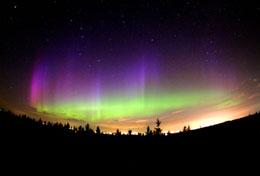Aurora
Borealis:
The
Earth is surrounded by a magnetic field which
emanates from the poles of the
Earth. Charged
particles from the
solar wind is pushed away from
the
Earth by this magnetic field, but sometimes the
particles interact with the magnetic field near the
poles.
These particles easily interact with the
Earth's
ionosphere resulting in a aurora of charged
particles.
 |
An aurora are the result of charged
particles of the solar wind interacting with
the
Earth's upper atmosphere - the
ionosphere. This is a still image, but there
will be movement like a curtain in the wind
when viewed directly. |
The name Aurora Borealis simply means aurora near
the north pole. It is worth noting that the aurora
is completely safe. I have yet to see an aurora in
person, but that is definitely on my list! To
predict an aurora, one simply monitors surface
activity on the
Sun. During the big solar flare
events last year, aurora activity was markedly
increased.
The
Space Environment Center has a website that
tracks the aurora. It's worth a look.
Aurora Australiais:
Aurora Australiais is identical to Aurora
Borealis, only that it occurs at the south pole.
Back to Top
|

